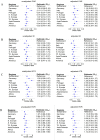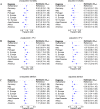Impact of geographic origin on access to therapy and therapy outcomes in the Swiss Hepatitis C Cohort Study
- PMID: 31233524
- PMCID: PMC6590815
- DOI: 10.1371/journal.pone.0218706
Impact of geographic origin on access to therapy and therapy outcomes in the Swiss Hepatitis C Cohort Study
Abstract
Late diagnosis and treatment may increase morbidity and mortality among persons with hepatitis C virus (HCV) infection. We included all participants of the Swiss Hepatitis C Cohort Study (SCCS). We used unadjusted and adjusted logistic and Cox regressions to determine the association between the geographic origin of the participants and the following outcomes: antiviral treatment status; sustained virologic response; cirrhosis at enrolment; incident cirrhosis; loss to follow-up (LTFU); and mortality. The analyses were adjusted for sex, baseline age, education, source of income, alcohol consumption, injection drug use (IDU), HCV genotype, HIV or HBV coinfection, duration of HCV infection, time since enrolment, cirrhosis, (type of) HCV treatment, and centre at enrolment. Among 5,356 persons, 1,752 (32.7%) were foreign-born. IDU was more common among Swiss- (64.1%) than foreign-born (36.6%) persons. Cirrhosis at enrolment was more frequent among foreign- than Swiss-born persons, reflecting the high frequency of cirrhosis among Italian-born persons who acquired HCV between 1950 and 1970 in Italian healthcare settings. Although antiviral treatment coverage was similar, the sustained viral response rate was increased and the mortality was lower among foreign-vs. Swiss-born persons, with the lowest mortality in persons from Asia/Oceania. LTFU was more frequent in persons from Germany, Eastern and Southern Europe, and the Americas. In conclusion, in Switzerland, a country with universal healthcare, geographic origin had no influence on hepatitis C treatment access, and the better treatment outcomes among foreign-born persons were likely explained by their lower prevalence of IDU and alcohol consumption than among Swiss-born persons.
Conflict of interest statement
I have read the journal's policy and the authors of this manuscript have the following competing interests: Barbara Bertisch has received travel grants from AbbVie, Gilead and ViiV and has received unrestricted research grants from Gilead. Beat Müllhaupt has served as an advisory board member for AbbVie, Boehringer Ingelheim, Bristol Myers Squibb, Gilead, Janssen-Cilag, MSD, Roche; as a consultant for AbbVie and Gilead; and has received research grants from Gilead and Roche. Francesco Negro has served as advisor for AbbVie, Bristol Myers Squibb, Gilead and MSD and has received unrestricted research grants from Gilead and AbbVie. Nasser Semmo has served as an advisory board member for Gilead and MSD and has received speaker`s fees from AbbVie. Olivia Keiser is funded by a professorship grant (no 163878) from the Swiss National Science Foundation. Matteo Brezzi, Benedetta Terziroli Beretta-Piccoli, David Semela and Darius Moradpour have declared no conflicts of interest. This does not alter our adherence to PLOS ONE policies on sharing data and materials.
Figures




Similar articles
-
Characteristics of Foreign-Born Persons in the Swiss Hepatitis C Cohort Study: Implications for Screening Recommendations.PLoS One. 2016 May 26;11(5):e0155464. doi: 10.1371/journal.pone.0155464. eCollection 2016. PLoS One. 2016. PMID: 27227332 Free PMC article.
-
Access to therapy and therapy outcomes in the Swiss Hepatitis C Cohort Study: a person-centred approach.J Viral Hepat. 2016 Sep;23(9):697-707. doi: 10.1111/jvh.12535. Epub 2016 Mar 23. J Viral Hepat. 2016. PMID: 27006320
-
Hepatitis C Virus Infection Outcomes Among Immigrants to Canada: A Retrospective Cohort Analysis.Ann Hepatol. 2017 Sep-Oct;16(5):720-726. doi: 10.5604/01.3001.0010.2714. Ann Hepatol. 2017. PMID: 28809741
-
Appendix: The National Institutes of Health Consensus Development Conference Management of Hepatitis C 2002.Clin Liver Dis. 2003 Feb;7(1):261-87. doi: 10.1016/s1089-3261(02)00078-8. Clin Liver Dis. 2003. PMID: 12691470 Review.
-
Epidemiology and management of hepatitis C virus infections in immigrant populations.Infect Dis Poverty. 2019 Mar 15;8(1):17. doi: 10.1186/s40249-019-0528-6. Infect Dis Poverty. 2019. PMID: 30871599 Free PMC article. Review.
References
-
- Poynard T, McHutchison J, Manns M, Trepo C, Lindsay K, Goodman Z, et al. Impact of pegylated interferon alfa-2b and ribavirin on liver fibrosis in patients with chronic hepatitis C. Gastroenterology. 2002;122(5):1303–13. - PubMed
-
- Manns MP, Buti M, Gane E, Pawlotsky J-M, Razavi H, Terrault N, et al. Hepatitis C virus infection. Nat Rev Dis Primer. 2017;3:17006. - PubMed
-
- Kanwal F, Hoang T, Spiegel BMR, Eisen S, Dominitz JA, Gifford A, et al. Predictors of treatment in patients with chronic hepatitis C infection—role of patient versus nonpatient factors. Hepatol. 2007;46(6):1741–9. - PubMed
-
- Carballo M, Maclean E, Gudumac I, Van Damme P. Hepatitis C and migration: a public health challenge. J Fam Med. 2016;3(4):1065.

